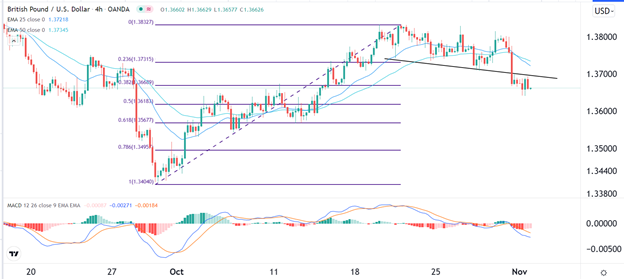Bearish View
Sell the GBP/USD and set a take-profit at 1.3600.
Add a stop-loss at 1.3750.
Timeline: 1-2 days.
Bullish View
Set a buy-stop at 1.3700 and add a take-profit at 1.3800.
Add a stop-loss at 1.3600.
The GBP/USD pair remained under pressure even after the relatively positive UK manufacturing output data. The pair dropped to 1.3665, which was about 1.25% below the highest level in October.
BOE and Fed Decisions
The UK and US manufacturing sectors did relatively well in October as companies continued wrestling with supply shortages and higher input costs. In the UK, data by Markit showed that Manufacturing PMI was at 57.8 in September, better than the previous 57.1.
In the US, data by Markit showed that the PMI declined from 60.7 to 58.7. This decline was worse than the median estimate of 59.2.
However, a separate report by the Institute of Supply Management (ISM) showed that the PMI dropped from 61.8 to 60.8. Still, these numbers provide signals that the manufacturing sector is doing well since they are above 50.
The biggest catalysts for the GBP/USD pair this week will be the Federal Reserve and the Bank of England (BOE) interest rate decisions scheduled for Wednesday and Thursday.
Analysts believe that these decisions will be relatively hawkish than the previous ones. While the two banks will leave their interest rate unchanged, they will likely talk about the quantitative easing program,
The Fed is expected to reduce its $120 billion per month asset purchase program by about $15 billion. It will do that until June next year. Also, analysts expect that the bank will signal that it will hike interest rates earlier than expected.
The Bank of England is also expected to sound hawkish since inflation has risen while the unemployment rate has fallen. As such, the bank will likely start tapering its asset purchases this week. The next key mover for the pair will be the latest US jobs numbers.
GBP/USD Forecast
The four-hour chart shows that the GBP/USD pair has been in a deep sell-off in the past few days. The pair has managed to move below the 38.2% Fibonacci retracement level. It has also fallen below the descending trendline that connects the lowest levels since October 20th.
Also, the 25-day and 50-day moving averages have made a bearish crossover pattern while the MACD has moved below the neutral line. Therefore, the pair will likely keep falling as bears target the 50% Fibonacci retracement level at 1.3620.

